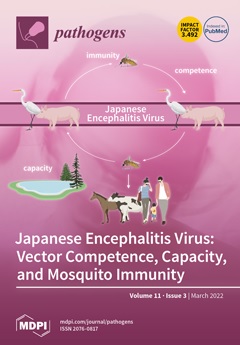View Item
- xmlui.general.dspace_homeCentros e Institutos de InvestigaciónCICVyA. Centro de Investigación en Ciencias Veterinarias y AgronómicasInstituto de PatobiologíaArtículos científicosxmlui.ArtifactBrowser.ItemViewer.trail
- DSpace Home
- Centros e Institutos de Investigación
- CICVyA. Centro de Investigación en Ciencias Veterinarias y Agronómicas
- Instituto de Patobiología
- Artículos científicos
- View Item
Unraveling the complexity of the rhomboid serine protease 4 family of Babesia bovis using bioinformatics and experimental studies
Abstract
Babesia bovis, a tick-transmitted apicomplexan protozoon, infects cattle in tropical and subtropical regions around the world. In the apicomplexans Toxoplasma gondii and Plasmodium falciparum, rhomboid serine protease 4 (ROM4) fulfills an essential role in host cell invasion. We thus investigated B. bovis ROM4 coding genes; their genomic organization; their expression in in vitro cultured asexual (AS) and sexual stages (SS); and strain polymorphisms. B.
[ver mas...]
Babesia bovis, a tick-transmitted apicomplexan protozoon, infects cattle in tropical and subtropical regions around the world. In the apicomplexans Toxoplasma gondii and Plasmodium falciparum, rhomboid serine protease 4 (ROM4) fulfills an essential role in host cell invasion. We thus investigated B. bovis ROM4 coding genes; their genomic organization; their expression in in vitro cultured asexual (AS) and sexual stages (SS); and strain polymorphisms. B. bovis contains five rom4 paralogous genes in chromosome 2, which we have named rom4.1, 4.2, 4.3, 4.4 and 4.5. There are moderate degrees of sequence identity between them, except for rom4.3 and 4.4, which are almost identical. RT-qPCR analysis showed that rom4.1 and rom4.3/4.4, respectively, display 18-fold and 218-fold significantly higher (p < 0.01) levels of transcription in SS than in AS, suggesting a role in gametogenesis-related processes. In contrast, transcription of rom4.4 and 4.5 differed non-significantly between the stages. ROM4 polymorphisms among geographic isolates were essentially restricted to the number of tandem repeats of a 29-amino acid sequence in ROM4.5. This sequence repeat is highly conserved and predicted as antigenic. B. bovis ROMs likely participate in relevant host–pathogen interactions and are possibly useful targets for the development of new control strategies against this pathogen.
[Cerrar]

Author
Gallenti, Romina Josefina;
Hussein, Hala E.;
Alzan, Heba F.;
Suarez, Carlos Esteban;
Ueti, Massaro W.;
Asurmendi, Sebastian;
Benitez, Daniel Francisco;
Araujo, Flabio Ribeiro de;
Rolls, Peter;
Sibeko, Kgomotso;
Schnittger, Leonhard;
Florin-Christensen, Mónica;
Fuente
Pathogens 11 (3) : 344 (Marzo 2022)
Date
2022-03
Editorial
MDPI
ISSN
2076-0817
Documentos Relacionados
Formato
pdf
Tipo de documento
artículo
Proyectos
(ver más)
INTA/2019-PD-E5-I102-001/2019-PD-E5-I102-001/AR./Desarrollo de vacunas y tecnologías para mejorar las estrategias profilácticas y terapéuticas de las enfermedades que afectan la producción animal y la salud pública
INTA/2019-PD-E5-I105-001/2019-PD-E5-I105-001/AR./Patógenos animales: su interacción con el hospedador y el medio ambiente. Impacto en productividad, ecosistemas, sanidad animal y salud pública en el marco “Una Salud”
INTA/2019-PE-E5-I109-001/2019-PE-E5-I109-001/AR./Convocatoria: Estudios para el control de enfermedades subtropicales y/o transmitidas por vectores (Tristeza Bovina, Garrapatas, Miasis, Tripanosomiasis, Lengua Azul y la
Palabras Claves
Derechos de acceso
Abierto
 Excepto donde se diga explicitamente, este item se publica bajo la siguiente descripción: Creative Commons Attribution-NonCommercial-ShareAlike 2.5 Unported (CC BY-NC-SA 2.5)
Excepto donde se diga explicitamente, este item se publica bajo la siguiente descripción: Creative Commons Attribution-NonCommercial-ShareAlike 2.5 Unported (CC BY-NC-SA 2.5)


